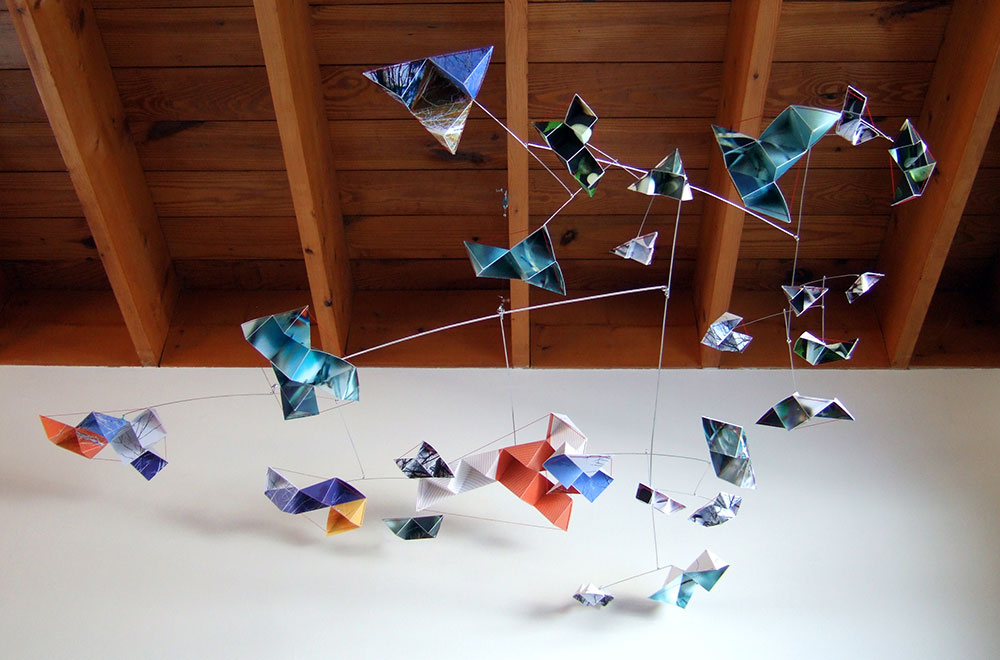Portraits of Randomness (2012)
Solo exhibition at CAP ArtSpace, Ithaca, NY in February 2012.
Exhibition Statement
For several years, my artistic output has consisted mainly of kinetic mobile sculptures in the style of Alexander Calder, who invented this authentically abstract art form using a modernist vocabulary focusing on new materials and clean lines. Recently, I began to see my mobiles through the lens of mathematics by applying my background as a physicist. Graph theory is a branch of mathematics in which the relationships between pairs of objects are often drawn as a network of nodes connected by edges. When I happened to map out the graph structure of a mobile, I noticed it had the same structure as a tree.
As with a tree, the branches of a mobile can, in principle, be extended recursively ad infinitum, leading to a self-similar object known as a fractal. When any small portion of a fractal is enlarged and magnified, it ends up looking like the original object. Fractals can be found everywhere, from the shapes of coastlines and mountain ranges to the complex connections among websites. That’s why a large mobile with many pieces sometimes resembles a cloud or a flock of birds.
Based on this realization, I started generating fractals with a random computer algorithm, and I put these shapes into my art. For many of the wall pieces here, I used a needle and thread to trace the outlines of these random fractals. This process gave me a series of low-relief embroidered drawings that approach the formal concept of randomness in a personal way.
This exhibit also contains sculpted prints, where digital photomontages have been cut and folded into a three-dimensional pattern of pyramids and squares. Here, I’m attempting to come to terms with a slightly different aspect of randomness and its relation to uncertainty.
Uncertainty, of course, is a consequence of randomness. We experience uncertainty because we cannot possibly gather all the data that’s available; we only see a tiny random selection of the whole. So, for me, knowledge is acquired by distilling individual facts into general ideas. For example, by observing the rising and setting sun, we gradually developed the notion of the calendar and cyclical time. Or, based on a small sampling of the general population, we can predict who wins an election. Our brains turn data into knowledge with such ease that we often don’t realize it. But in fact, all of our fields of study, and even much of our daily lives, are devoted to this deceptively simple act of transformation.
I would suggest, then, that knowledge is not to be contrasted with ignorance, but rather with raw data itself. Not good versus evil, but chocolate versus vanilla. With the rise of data-driven digital media, there has been a corresponding fragmentation of knowledge. I believe my sculpted prints are depicting, in some way, this new decentralized outlook that celebrates the accumulation of data for its own sake. Indeed, if our brains were capable of holding all the information in the universe, there would be no need for knowledge at all. But as it is, we muddle through with limited data and partial knowledge, striving constantly for a singular, mythical vision of infinity.









![The Penelope Project [White] Archival inkjet print, paper, and thread 14” x 11” 2011](https://images.squarespace-cdn.com/content/v1/54754013e4b086c763c26a4c/1546566750931-R55LL9E8NOF7S82FP1QN/fracthread015.jpg)





![Outlines of Reality [Green] Acrylic and thread on paper 24” x 19” 2011](https://images.squarespace-cdn.com/content/v1/54754013e4b086c763c26a4c/1546567257540-5BTCFVTLOLCRLLO72FD6/DSCF4140.jpg)
![Outlines of Reality [Blue] Acrylic and thread on paper 24” x 19” 2011](https://images.squarespace-cdn.com/content/v1/54754013e4b086c763c26a4c/1546567275785-LH7Y5DRW8B96I86R59QF/DSCF4185.jpg)
![Outlines of Reality [Green] (detail) Acrylic and thread on paper 24” x 19” 2011](https://images.squarespace-cdn.com/content/v1/54754013e4b086c763c26a4c/1546567303757-QNFXQPUOW9NGWWE3N9JG/DSCF4144.jpg)